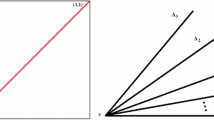Abstract
The paper is based on extensive research carried out on students of mathematics who had completed a university course of calculus. The basic purpose of the research was to determine the students' images of the concept of limit, that is to find out their associations, conceptions and intuitions connected with limits and to determine the degree of their efficiency and the sources of their formation. To achieve the objectives an expanded set of selected problems — simple but not quite standard — and various other research instruments were used. Several classes of images of the limit concept have been identified and described, according to their main foci: neighborhoods, graph approaching, values approaching, being defined at x0, limit of f atx0 equals f(x0), and algorithms.
Similar content being viewed by others
REFERENCES
Brousseau, G.: 1997, Theory of Didactic Situations in Mathematics, Kluwer Academic Publishers, Dordrecht.
Cornu, B.: 1983, Apprentissage de la notion de limite: conceptions et obstacles, Doctoral Dissertation, Université Scientifique et Médicale, Grenoble.
Davis, R.B. and Vinner S.: 1986, 'The notion of limit; some seemingly unavoidable misconception stages', The Journal of Mathematical Behavior 5, 281–303.
Dubinsky, E.: 1991, 'Reflective abstraction in advanced mathematical thinking', in D. Tall (ed.), Advanced Mathematical Thinking, Kluwer Academic Publishers, Dordrecht, pp. 95–126.
Dubinsky, E.: 1992, 'A learning theory approach to calculus', in Z.A. Karian (ed.), Symbolic Computation in Undergraduate Mathematics Theory, MAA Notes 24, Washington, pp. 43-55.
Ervynck, G.: 1981, 'Conceptual difficulties for first year university students in the acquisition of the notion of limit of a function', Proceedings of the Fifth Conference of the International Group for the Psychology of Mathematics Education, Berkeley, pp. 330-333.
Ferrini-Mundy, J. and Graham, K.: 1994, 'Research in calculus learning: understanding of limits, derivatives and integrals', in J. Kaput and E. Dubinsky (eds.), Research Issues in Undergraduate Mathematics Learning, MAA Notes 33, Washington, pp. 31-45.
Fischbein, E., Tirosh, D. and Hess, P.: 1979, 'The intuition of infinity', Educational Studies in Mathematics 10, 3–40.
Fischbein, E.: 1987, Intuition in Science and Mathematics. An Educational Approach, D. Reidel Publishing Company, Dordrecht.
Goldin, G.A.: 1990, 'Epistemology, constructivism, and discovery learning in mathematics', Journal for Research in Mathematics Education, Monograph number 4 -Constructivist views on the teaching and learning of mathematics, pp. 31-47.
Harel, G. and Trgalova, J.: 1996, 'Higher mathematics education', in A.J. Bishop, K. Clements, C. Keitel, J. Kilpatrick and C. Laborde (eds.), International Handbook of Mathematics Education, Kluwer Academic Publishers, Dordrecht, pp. 675–700.
Jung, C.G.: 1971, Psychological types, Princeton University Press, Princeton. Longman Dictionary of Contemporary English: 1987, Longman Group UK, London.
Mitroff, I.I. and Kilmann, R.H.: 1975, 'On evaluating scientific research: The contribution of the psychology of science', Technological Forecasting and Social Change 8, s. 163–174.
Noddings, N.: 1990, 'Constructivism in mathematics education', Journal for Research in Mathematics Education, Monograph number 4-Constructivist views on the teaching and learning of mathematics, pp. 7-18.
Nosal, C.S.: 1992, Diagnoza typow umyslu, PWN, Warszawa.
Piaget, J.: 1977, The Development of Thought: Equilibration of Cognitive Structures, The Viking Press, New York.
Prochnicka, M.: 1991, Informacja a umysl, Universitas, Krakow.
Przenioslo, M.: 2000, Rozumienie granicy funkcji wyniesione ze szkoly sredniej, Takt, Kielce.
Przenioslo, M.: 2001, 'Trudnosci zwiazane z procesem poznawania podstawowych pojec analizy matematycznej', Annales Societatis Mathematicae Polonae, series V -Dydaktyka Matematyki 23, pp. 95–124.
Przenioslo, M.: 2002, Obraz granicy funkcji uksztaltowany w czasie studiow matematycznych, Wydawnictwo Akademii Swietokrzyskiej, Kielce.
Robert, A. and Boschet, F.: 1981, 'L'acquisition du concept de convergence des suites numériques dans l'enseignement supérieur', Bulletin APMEP 330, pp. 649–674.
Robert, A.: 1982, 'L'acquisition de la notion de convergence des suites numériques dans l'enseignement supérieur', Recherches en Didactique des Mathématiques 3, 307–341.
Schwarzenberger, R.L. and Tall, D.: 1978, 'Conflict in the learning of real numbers and limits', Mathematics Teaching 82, 44–49.
Sierpinska, A.: 1985, 'Obstacles épistémologiques relatifs à la notion de limite', Recherches en Didactique des Mathématiques 6, 5–68.
Sierpinska, A.: 1987, 'Humanities students and epistemological obstacles related to limits', Educational Studies in Mathematics 18, 371–397.
Sierpinska, A.: 1990, 'Some remarks on understanding in mathematics', For the Learning of Mathematics 10, 24–36.
Sierpinska, A.: 1994, Understanding in Mathematics, The Falmer Press, London.
Sierpinska, A.: 1998, 'Three epistemologies, three views of classroom communication: constructivism, sociocultural approaches, interactionism', in H. Steinbring, M.G. Bartolini Bussi and A. Sierpinska (eds.), Language and Communication in the Mathematics Classroom, National Council of Teachers of Mathematics, Reston, pp. 30–62.
Steffe, L.P. and Gale, J. (eds.): 1995, Constructivism in Education, Lawrence Erlbaum Association Publishers, Hillsdale, New Jersey.
Tall, D. and Vinner, S.: 1981, 'Concept image and concept definition in mathematics with particular reference to limit and continuity', Educational Studies in Mathematics 12, 151–169.
Tall, D.: 1991, 'The psychology of advanced mathematical thinking', in D. Tall (ed.), Advanced Mathematical Thinking, Kluwer Academic Publishers, Dordrecht, pp. 3–23.
Tall, D.: 1996, 'Function and calculus', in A.J. Bishop, K. Clements, C. Keitel, J. Kilpatrick and C. Laborde (eds.), International Handbook of Mathematics Education, Kluwer Academic Publishers, Dordrecht, pp. 289–325.
Vinner, S.: 1991, 'The role of definitions in the teaching and learning mathematics,' in D. Tall (ed.), Advanced Mathematical Thinking, Kluwer Academic Publishers, Dordrecht, pp. 65–81.
Vygotskii, L.S.: 1962, Thought and Language, The M.I.T. Press, New York.
Williams, S.: 1991, 'Models of limits held by college calculus students', Journal for Research in Mathematics Education 22(3), 219–236.
Author information
Authors and Affiliations
Rights and permissions
About this article
Cite this article
Przenioslo, M. Images of the limit of function formed in the course of mathematical studies at the university. Educational Studies in Mathematics 55, 103–132 (2004). https://doi.org/10.1023/B:EDUC.0000017667.70982.05
Issue Date:
DOI: https://doi.org/10.1023/B:EDUC.0000017667.70982.05




